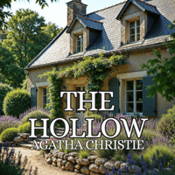
Overview
Synopsis
Agatha Christie’s The Hollow unfolds at the country estate of Sir Henry and Lady Lucy Angkatell, where a weekend gathering of family and friends takes a dark turn. Among the guests are the sculptor Henrietta Angkatell, the devoted but insecure Gerda Cristow, and her husband, the charismatic Dr. John Cristow, who is entangled in both a past romance with film star Veronica Craye and a present affair with Henrietta. Tensions simmer beneath the surface as old loves, class differences, and jealousies bubble up—until a gunshot shatters the weekend calm, leaving Dr. Cristow dead and everyone a potential suspect.
Inspector Colquhoun arrives to untangle the mystery, uncovering a web of deception, misplaced affections, and quiet despair. Suspicion falls on nearly everyone—from the flighty Lady Lucy to the heartbroken Edward Angkatell—but the truth lies closer to home than expected. In classic Christie fashion, the murder’s solution hinges on human weakness and emotional complexity rather than mere cunning. The Hollow combines domestic comedy, tangled romance, and psychological intrigue, making it one of Christie’s most character-driven and subtly tragic mysteries.
Show Information
Context
Agatha Christie wrote The Hollow in 1951, adapting it from her 1946 novel of the same name. Although the book features her famous detective Hercule Poirot, Christie chose to remove him from the stage version, believing that his presence would distract from the emotional depth of the other characters. Instead, she focused on the psychological tensions and moral ambiguities that drive the story, shifting the emphasis from pure detective puzzle to domestic drama. The result is one of her most
to read the context for The Hollow and to unlock other amazing theatre resources!Plot
Act One
The play opens at The Hollow, the country home of Sir Henry and Lady Lucy Angkatell. Henrietta Angkatell, Henry’s artistic cousin in her thirties, is busy working on a sculpture while Sir Henry reads the newspaper. Lady Lucy enters, charmingly scatterbrained as ever, and rambles about moles in the garden. The couple discuss the weekend ahead, as several guests are due to arrive.
The first to appear is Midge Hardcastle, another cousin. She and Henrietta reminisce fondly about
to read the plot for The Hollow and to unlock other amazing theatre resources!Characters
| Name | Part Size | Gender | Vocal Part |
|---|---|---|---|
|
Lead |
Female |
Non-singer |
|
|
Lead |
Female |
Non-singer |
|
|
Supporting |
Male |
Non-singer |
|
|
Supporting |
Female |
Non-singer |
|
|
Supporting |
Male |
Non-singer |
|
|
Supporting |
Male |
Non-singer |
|
|
Supporting |
Female |
Non-singer |
|
|
Supporting |
Female |
Non-singer |
|
|
Supporting |
Male |
Non-singer |
|
|
Featured |
Male |
Non-singer |
|
|
Featured |
Male |
Non-singer |
|
|
Featured |
Female |
Non-singer |
Songs
A song with an asterisk (*) before the title indicates a dance number; a character listed in a song with an asterisk (*) by the character's name indicates that the character exclusively serves as a dancer in this song, which is sung by other characters.
Monologues
Scenes
Key Terms
An adaptation is a reworking of a story from one medium or cultural context into another, such as turning a novel into a play or updating a classic play’s setting. Adaptations often reinterpret themes, characters, and style for new audiences. They can range from faithful recreations to bold reimaginings.
Characters representing the aristocracy or wealthy elite, often portrayed with distinct costume, accent, and mannerisms.
A mystery plot where the audience follows clues to identify the perpetrator, often used in suspenseful or comedic theatre.
Videos
Quizzes
Themes, Symbols & Motifs
THEMES
__Love, Jealousy, and Emotional
to read about the themes, symbols and motifs from The Hollow and to unlock other amazing theatre resources!Quote Analysis
Sorry! We do not currently have learning modules for this guide.
